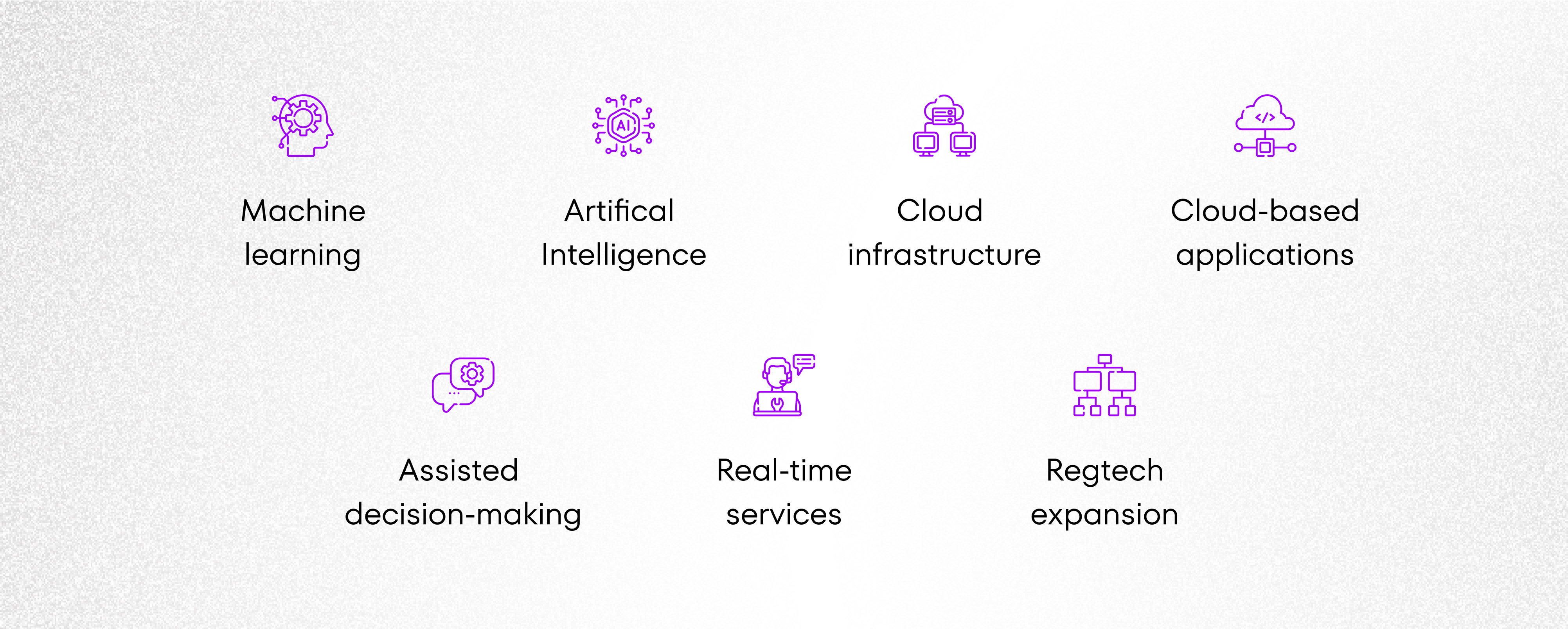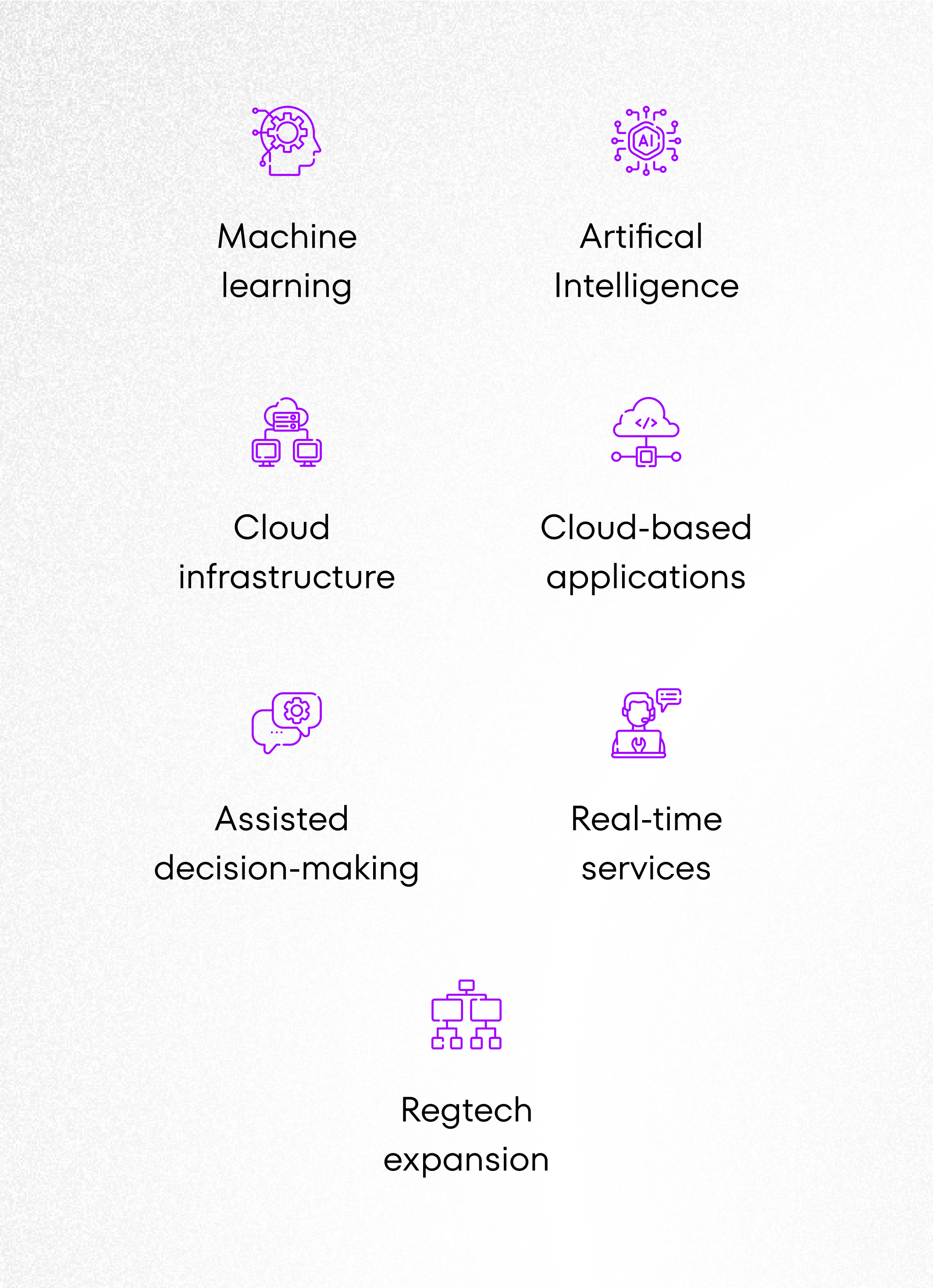April 22nd, 2021
The State of RegTech 2021. What Affects Its Advancement and How to Accelerate Innovation in Regulatory Processes Within the Financial Industry

Table of contents
Is regulatory technology slowing down? What is holding up the adoption of new technology, and how can we make it faster and less risky? How can IT organizations add oxygen to the burning-hot industry?
Insights from the heart of the RegTech industry
With over 15 years of IT experience and almost 10 in FinTech and RegTech, I am lucky enough to have a front-row view of the changes that banks and financial organizations are going through. Being a co-founder of CSHARK, a software company working closely with RegTech industry leaders, I often draw on that experience as I find it highly educational and humbling.
This February, I had the privilege of sharing my insights at Sthlm Fintech Week 2021 and now this article has come to life.

What can you find out?
- Where is RegTech now, and how mature it is in adopting innovative technology?
- 5 reasons that adversely affect the advancement of RegTech with ways that could accelerate the innovation.
- 5 areas and technologies that are becoming increasingly popular in RegTech.
- View into the near future – where is regulatory technology heading?
Where is RegTech now, and how mature it is in adopting innovative technology?
The larger the organization, the slower the change?
RegTech continues to grow at a quick pace. We still find innovative ways to use technology faster than we can adopt it in the regulatory & compliance space. Especially for the big players, such as global banks and complex financial institutions, implementing new solutions is still slow on the uptake. Those organizations are great machines with their momentum and inertia and cannot change course swiftly. Obviously, we can see how some of the biggest banks have started fundamental transformation programs; nevertheless, the change is still slow.
How much do we trust the data we capture?
Data quality and its significance we have been gathering since the late ’90s are in question. It feels like we almost have too much information but not enough of it we can use. Two or three years ago, we optimistically looked at what data can do for us: streamline processes, recognize patterns, and reduce overall operations cost across the board.
Right now, it seems that we have too much data than the capacity of human processing power can handle. To make it applicable, we need computers and machine learning to help, believe it or not, they are exceptionally good at this. Once the initial filtering is done and the value of the data that is left is assessed, we want to ensure that we can quickly select the critical information from the noise. Only now we allow humans ingenuity to shine when interpreting and drawing conclusions. Moreover, the knowledge workers and data scientists can really focus on what they are best at.
In 2021, digitization is no longer appreciated. It is a must-have
The regulatory scope is expanding both in the number of regulations and in the level of detail. We can see standardization attempts, but with the increased demand for more online and real-time services that need to be regulated, the scope is still growing.
Demand for digitalization is on a steady rise as well. Still, in 2020 we all felt the need to access online services in all aspects of our lives: banking, stock market, buying groceries, or consulting doctors or trainers. We have experienced online access in the past as an option, but the last year has shown that businesses that can’t go online won’t be competitive and eventually will be left behind.
We are still finding innovative ways to utilize technology faster than we can mass-adopt it. In some cases, we had to wait until legislation and policies caught up to adopt new technologies. For example, for banks, cloud services and storing sensitive data online is a very complex topic. With blockchain and distributed ledgers, we had to wait until we could fully appreciate these technologies’ benefits to protect us against unwanted and unauthorized changes.
5 reasons that can adversely affect the advancement of regulatory technology
- Settings objectives not aligned with the business goals
- Not “selling” and convincing people to innovative ideas
- Unreasonably lengthy decision-making processes in big organizations
- Expensive implementation of new technologies
- Not being able to explain the benefits of innovative ideas
Big picture, clear vision, and being on the same page
Internal misalignment is a recipe for disaster. Different opinions are healthy and challenge us to create better solutions and clarify our visions; however, once agreed and direction is set, we should be consistent.
In my experience, technology leaders’ delivery objectives sometimes are not aligned with the business goals. There is a lot of churn and compromises made during the delivery because the objectives were misaligned from the very beginning. I believe that ‘teamwork makes the dream work’. It pays to focus on clear communication and clearly defined goals.
Sustainable change is not about systems and processes – it’s about people
Humans, like all animals, are averse to change by nature. Adopting something unknown requires effort and taking risks, which demands stepping out of the comfort zone. A fundamental shift is not just about systems, solutions, and new processes but mostly about people. If people are not comfortable with the goals and decisions being handed top-down, they will not advocate and carry the “torch of change”.
Sometimes we are so convinced that new technology will solve all the problems that we forget to explain it to others. The best way to win “hearts and minds” is by using plain language and analogues.
I have seen great ideas and innovative technology initially frowned upon and rejected just because people couldn’t understand them. Examples? Read more about anti-electricy movement or 5G networks.
Decision-making processes in big organizations
Big organizations’ decision-making process can take months, especially when trying to adopt innovative technology. Organizations need to change how they run at the governance and administrative level to benefit from newly emerging solutions. It requires reorganizing at the core, allowing shorter delivery lifecycles, closing the feedback loop between delivery and end-users. Generally, be less stagnant and less of a waterfall.
Mass production reduces the cost of new technologies
Almost every piece of new technology is expensive if it is not mass-produced, or mass adopted. If you think about payment terminals or IOT devices – they were costly in the old days. Technology gets cheaper by producing it in bulk and results in the IoT revolution.
Sometimes the technology is good, but the timing is not right
Timing is crucial. We have seen how new technologies failed because the timing was just not right: VR, augmented reality glasses, 3D television. Sometimes you miss the right moment.
The same applies to blockchain introduction that was too early, in my opinion – everyone started using it as a buzzword even before we could put it into practice.
This kind of hype can be very similar in consequence, although on a much smaller scale, to the stock market bubble, and it is challenging to find the objective value of technology and its benefits.
5 things that accelerate the adoption of innovative technology in RegTech
Compliance is a marathon, not a sprint
We need to stop looking at being compliant as a goal. The ultimate goal is to achieve and sustain compliance. That changes the way we structure our organizations. It needs to become part of the values that people will want to follow – ingrained in their DNA.
We can look at this the same way as we would look at “the infinite games” and inadvertently help drive new technology adoption. It will bring people on board and support plan resource allocation – for a marathon, not a sprint.
Technology and RegTech in particular allow us to be more disciplined and consistent in enforcing that approach. It limits the possibilities of bad judgment and “creative interpretations” of rules and policies, by finding patterns of fraudulent behavior and codification of natural-language rules.
Remember, we never stop “selling”
We would not advocate new technologies if we got burned in the past. To encourage everyone to support change and adopt new ideas, we need to understand people’s motives and present our reasons clearly. We are wired in a way that we are always “selling” – whether it is a vision, our product, our services, or just an idea. If you want to be a natural leader that people respect and follow, don’t rely on discipline and hierarchy. The same rule applies to the implementation of innovative technology.
Critical thinking
To adequately address the organization’s issues and effect a fundamental change, you need to acknowledge mistakes and pain points within current processes and working ways. Simple as that.
Adjust the design process
The necessary steps to effectively adopt new technology are:
- adjusting the design to look at capabilities rather than systems,
- anchoring solutions in business processes and key objectives,
- looking at information architecture instead of just data.
This all sounds simple, but unfortunately, we often see when the problem is being made up to fit an existing solution – instead of the other way around. It is essential to allow creative juices to flow and we can only do that once we have objectively uncovered the real problem statement. That is why architecture is so critical in IT.
The best way to prove new technologies is an MVP
A perfect way to test a new technology or approach when we are not sure it is the right direction is to develop a Minimal Viable Product. Think small, fail small – this might not be a trendy thing to say to visionaries, but it works well when prototyping and planning for quick go-to-market delivery.
The big picture is something that we need to go back to constantly. Otherwise, the risk is we will get distracted with the smallest steps of our journey. That’s why we need to balance our MVP with an unobscured view of our transformation path’s progress and keep our core values in the back of our heads.
5 areas and technologies that are already becoming increasingly popular in RegTech


Warning: Undefined array key “caption” in /var/www/cshark/releases/14/web/app/themes/cshark/template-parts/blocks/image-section/image-section.php on line 37
Machine Learning and AI
I expect to see more machine learning and AI in the future because they help classify and filter through the noise of all the data we gather. We will not just try to extract information and patterns as we started doing with Big Data analytics, but also rank the information in terms of its importance and filter out rubbish. We already see a lot of that in AML screening systems, but in most cases, people work out the heavy lifting, because we are not prepared to handle that much information effectively.
Ultimately, the quality and significance of data will make or break processes built on top of it.
Cloud infrastructure and cloud-based applications
We already see that the use of cloud infrastructure and cloud-based applications is picking up the pace. The policies are getting more relaxed, and compliance is starting to be more comfortable putting data into machines that the organizations themselves do not physically own.
This is happening with a tremendous effort from cloud providers to legitimize technology and prove its security and safety. There are still jurisdictional data restriction issues, but we see that global banks are coming together to the table to challenge and change some of those policies that can enable more bold cloud adoption.
Meanwhile, big projects already take advantage of templated DevOps processes on low-grade and non-critical environments reducing running and maintenance costs, deployments time, and ensuring outcome consistency.
Assisted decision-making
Over the next few years, we would still prefer assisted decision-making, especially for high-risk and mission-critical areas. We will need human interaction to provide final approval and sign-off of the decisions in such a case. However, we are already starting to analyze the business data and operators’ and knowledge workers’ behavior to help them in the decision-making process.
Machine learning can help with that, hinting at how similar use cases have been resolved in the past, extrapolating the information on a full scale of the applications. But, if you fear massive layoffs, I don’t think we trust the machines that much yet. They will help with what humans struggle with, allowing operations to focus on the most essential and exceptional scenarios.
Real-time services
Digitalization is pushing for more online and real-time services, electronic payments, cryptocurrencies, peer-to-peer transactions that are a challenge for regulators. We cannot solve these challenges without automation and machines‘ help.
That drive for online services also creates new grounds for innovation. With the need for speed, we want to prevent identity theft and fraud through biometrics to ensure that the person accessing our data is authorized.
RegTech expansion beyond FinTech and InsurTech
Finally, we will see Further expansion of regulatory technology into industries outside of the indigenous and natural space of FinTech and InsurTech. Other segments can benefit from similar solutions, in medical, civil engineering, government agencies, law-making, and more.
The incentives are not as significant and visible as in the financial industry, but the long-term benefits can surprise us and eventually outweigh those currently only indigenous to FinTech.
View into the near future – where is regulatory technology heading?
We are not running out of solutions that RegTech can use to thrive. Technology is an enabler and a tool that we can use in many ways. Most of the tech we are today labeling as “ground-breaking” was available at least ten–twenty years ago. However, the way we use it is changing, and new innovative releases happen all the time, pushing our boundaries step by step.
Another thing is the way we use, mass adopt and reduce the maintenance cost of the tools that made a cloud, machine learning, and artificial intelligence an amazing alternative to conservative approaches.
Bear in mind that two or three years ago, we talked about the abundance of data. Currently, we are overwhelmed by it and now, with the use of innovative technology, we can refocus on the quality of data.
Inevitably, technology is the pillar that lifts FinTech and RegTech’s growth. Let’s create even more opportunities for the future, together.


